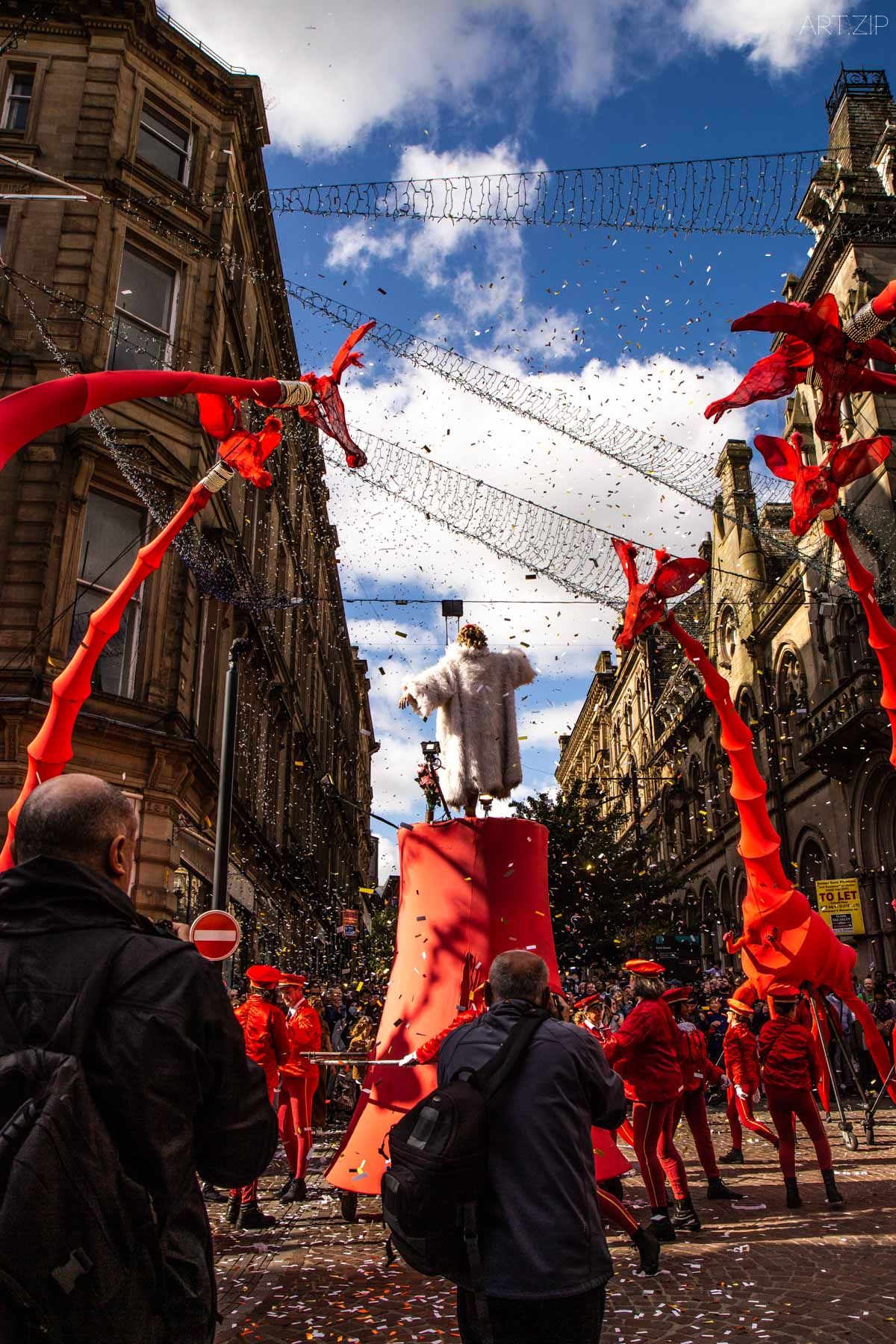
In the philosophy of Jean-Luc Nancy, sound is both a medium of transmission and a way of being. Even when its source fades, the echo remains; when space becomes a resonating chamber and the body begins to vibrate with it, the individual and the world, past and present, are joined anew through the experience of listening.
It is in this sense that Bradford has been awakened by a new generation of artistic practices. Silent histories and unfinished stories are once again being heard, carried forward through a succession of public art interventions.
Standing on the gravel, the wind sweeps across the moors of West Yorkshire, carrying with it the peculiar stillness and tension of the uplands. Inside the old wool warehouses, the sound of the looms seems yet to have faded—the murmurs of workers, the friction of cloth, the hiss of steam, and the faint movements beneath the wooden floors once formed the basic rhythm of labour. These sounds have never entirely disappeared; they linger between Bradford’s landscapes and buildings, composing the city’s auditory memory.
Sound is a thread that runs from Bradford’s history into its future. From industry to post-industry, from migration to settlement, from vanished mills to newly born cultural spaces, it continues to set the tempo of the city. In 2025, Bradford was named the fourth UK City of Culture. Across an administrative area of 141 square miles, hundreds of exhibitions, performances, installations, and public art projects unfold throughout the year, embedded into the city’s daily life like rests and crescendos in a musical score. They are scattered across former textile mills, railway stations, riversides, uplands, and neighbourhoods, forming a fluid symphony of the city.
This article follows three intertwined paths: hearing into history, tracing the industrial memories embedded in sound; walking into lives, exploring artistic interventions across diverse spaces; and seeing into thought, asking how contemporary art can operate within today’s social and political realities, in a “non-elite” city, to leave a cultural legacy that is both enduring and open.
在Jean-Luc Nancy的哲學中,聲音是一種傳達的媒介,亦是一種存在的方式。當聲源隱去,其回響仍然在場;當空間化作聲腔,身體發生共鳴,個體與世界、歷史與當下便通過聽覺經驗重新聯結。
正是在這樣的維度上,布拉德福德(Bradford)被新一代的藝術實踐重新喚醒,那些沈默的歷史與未竟的故事,在一次次的公共藝術行動中被再次聽見。
站在石礫之上,風掠過西約克郡高地,帶來一種荒原特有的寂靜與張力。在老舊的羊毛倉內,織機的聲音似乎尚未散去,勞工的私語、布匹的摩擦、蒸汽的噴湧、地板下傳來的窸窣聲,曾是勞動現場最基本的節奏。那些聲音似乎從未消失,它們留在布拉德福德的地貌與建築之間,構成這片土地的聽覺記憶。
聲音,是布拉德福德通往歷史與未來的線索。從工業到後工業,從遷徙到定居,從消失的廠房到新生的文化空間,它持續帶動著這座城市的節奏。2025年,布拉德福德被選為第四屆「英國文化之城」(2025 UK City of Culture)。在覆蓋141平方英里的行政區內,貫穿全年的數百場展演、裝置與公共藝術行動被嵌入城市日常,如同樂譜上的休止與強音,分布於舊紡織廠、火車站、河岸、高地與社區之間,匯成一部流動的城市交響。
本文沿三重路徑展開:由聲入史,追溯沈積在聲音中的工業記憶;由地入人,探索分布在多元空間中的藝術介入;由觀入思,試問當代藝術如何在當下的社會政治現實中,在一座「非精英城市」中發揮公共作用,為未來留下既堅固又開放的文化遺產。
1. Hearing into History: The Voices of a City 由聲入史:一座城市的聲音
Since 2013, the UK government has selected one “City of Culture” every four years, providing central and local public funding, infrastructure upgrades, and support for artistic projects. In 2025, Bradford received this title. The city’s cultural team built its programme around the principle of for the community, by the community, emphasising the participation of young people and marginalised groups, and launching a year-long series of co-created cultural initiatives.
Bradford was named the world’s first UNESCO City of Film in 2009. It is home to the National Science and Media Museum and a rich film industry network, and has long promoted film education and community-based film projects. Yet, if we trace its cultural narratives back to their origins, the city’s story is not only one of theatres and cinema screens, but also of an industrial past shaped by landscape, architecture, and migration.
Long before it became a City of Film, Bradford had another global title: the Wool Capital of the World in the mid-Victorian era. The roar of textile machinery, the hiss of steam, and the whir of spinning yarn together formed the city’s first soundtrack. Between the damp uplands of Yorkshire and the steady-flowing rivers, water-powered textile mills flourished, and factories, chimneys, and workers’ districts quickly spread. With the arrival of large numbers of South Asian migrants, the rhythm of the looms entered households as well, weaving together economic structures, class relations, and migration experiences into the everyday soundscape.
作為英國政府自2013年起每四年評選一次的重要文化計劃,「英國文化之城」為入選城市提供中央及地方公共資金、基礎設施升級與藝術項目支持。2025年,布拉德福德獲得這一稱號,城市的文化團隊圍繞「為社區發起、為社區服務」的理念展開策劃,強調青年與邊緣群體的參與,在全年內展開「社區共建」文化項目。
布拉德福德曾於2009年被聯合國教科文組織授予全球首個「世界電影之都」稱號,它不僅擁有英國國家媒體博物館(National Science and Media Museum)與豐富的銀幕產業資源,也致力於長期推動影像教育與社區影像計劃。但從影像的源頭回望,這座城市講述的不僅是劇場和銀幕上的故事,更是一段與地貌、建築和移民交纏的工業歷史。
早在成為電影之都之前,布拉德福德已有另一項全球性稱號:維多利亞時代中期的「世界羊毛之都」。紡織機器的轟鳴、蒸汽的咆哮與紗線的飛旋,共同構成了這座城市的第一重聲音。在潮濕的約克郡高地與流速適宜的河道之間,水力紡織廠應運而生,廠房、煙囪和勞工街區迅速擴展。隨著大量南亞移民的湧入,織機的節拍也進入了家庭,經濟結構、階級關係與遷徙經驗,在日常聲音中逐漸成形。
While the landscape of Bradford is an extension of the moors. In the tradition of British literature, the moor is often cast as a metaphorical terrain for the mind and for fate—a place of perpetual mist, where severity, endurance, and a quiet defiance form its essential character. As Emily Brontë *1 wrote in Wuthering Heights: “Heaven did not seem to be my home; and I broke my heart with weeping to come back to earth… into the middle of the heath on the top of Wuthering Heights; where I woke sobbing for joy.”
It is against this backdrop of history and terrain that the City of Culture 2025 public art projects take shape. Artists use sound as a thread to respond to the intersections of history, nature, and the future. The local sound collective Turbynes launched CHANNELS, a project that designates three man-made bodies of water as listening points: the Bingley Five Rise Locks, the Chellow Dean Reservoirs, and the Mirror Pool in City Park. Here, water becomes a conductor of time and memory, and listening draws audiences into narrative. Wooden benches with built-in acoustic devices play three overlapping soundscapes—oral histories, field recordings, and synthetic compositions. At the Locks, former workers recall the shipping peak a century ago; at the reservoir, voices recount wartime rationing; at the Mirror Pool, young residents imagine the city’s waterways in an era of climate change.
而地貌之上的布拉德福德則是荒原的延續。在英國文學傳統中,荒原常被視為心理與命運的隱喻之地,終年濕霧繚繞,使冷峻、忍耐與靜默中的抗衡,成為它的精神質地,正如 艾米莉·勃朗特(Emily Brontë)*1 在《呼嘯山莊》中所寫:「我靈魂的每一次掙扎,似乎都來自那荒野的回聲。」
2025文化之城的公共藝術項目正是在這樣的歷史與地貌背景之下展開。藝術家們以聲音作為線索,回應歷史、自然與未來的交匯。本土聲音組合Turbynes發起的「CHANNELS」項目選取三處人造水體作為聆聽點:賓利五級船閘(Bingley Five Rise Locks)、Chellow Dean蓄水池與市政公園的鏡池(Mirror Pool)。水成為時間與記憶的導體,聆聽將觀者帶入敘事,木質長椅內嵌聲學裝置,播放以口述史、現場錄音與合成音景交疊的三段聲音:水閘工人回憶百年前的船運高峰,蓄水池邊講述的是戰時配給的往事,鏡池則邀請年輕居民想象氣候變化下的城市水系。
The immersive theatre production The Railway Children, adapted from E. Nesbit’s novel of the same name*2, begins at Keighley station, where the audience boards a steam train bound for Oxenhope along the old Worth Valley line. The performance unfolds in the engine shed, yet the journey itself is already part of the play. In the novel, three children are forced to move to Yorkshire after their father is wrongly imprisoned. That narrative is re-experienced through the synchrony of real railway tracks and the hiss and rumble of steam. Stage, train, and audience inhabit a single timeline, bringing the past into the present through embodied perception.
Further out in the highlands, the Wild Uplands programme takes artists deep into the moors, responding to industrial heritage and the climate crisis from the perspective of the natural environment. Through the act of walking and listening, the intertwined relationship between industry and nature—at once symbiotic and abrasive—gradually comes into view.
In the nearby town of Saltaire, one of the most anticipated exhibitions of the year, We Will Sing by American artist Ann Hamilton, unfolds in the three-storey space of a former textile mill. From the ceiling hang over ten thousand threads; each movement of a visitor subtly alters the tension between thread and fabric, triggering low-frequency resonances. In Hamilton’s hands, these simple fibres become resonating chambers, echoing Bradford’s textile history while hinting at the shifting fortunes of manufacturing in the era of globalisation.
In the rumble of steam trains, the moorland winds, the vibration of threads, and the rush of water through canal locks, Bradford’s soundscape is reawakened. No longer merely the residue of an industrial past, it emerges as a renewed narrative mechanism for perception and place. Artists are exploring how, in a contemporary context, art might intervene in society, through a cultural network woven from collaboration, difference, and consensus, to address what constitutes place and belonging. And they leave open a question: how might a city be heard anew, and how might sound reconstruct local experience while shaping the future?
沉浸式劇場《鐵路少年 (The Railway Children) 》改編自Edith Nesbit的同名小說*2 ,觀眾在基斯利(Keighley)站登上蒸汽火車,沿著沃思谷(Worth Valley)舊鐵路駛向奧克森霍普(Oxenhope),劇場就在機車棚中。這段旅程本身就是演出的一部分。小說里三名兒童因父親被錯判而舉家遷至約克郡的情節,在真實軌道與蒸汽聲音的配合下獲得了一種「再經歷」,舞台、列車與觀眾共處一條時間軸,使歷史以身體感知的方式重回當下。
在更遠處的高地,《荒野高地 (Wild Uplands) 》計劃將藝術家帶到荒原深處,從自然出發,回應工業遺產與氣候危機。有作品以風動裝置模擬礦井深處的回聲,也有團隊在山坡上架起以防風廢料製成的風帆,還有沿牧道布設的聲音裝置,將舊時牧羊人的故事轉化為移動的聲景。行走與聆聽之間,工業與自然彼此共生又相互磨損的關係逐漸浮現。
索爾泰爾(Saltaire)是坐落於布拉德福德周邊的小鎮,這裡登場的是本年度最受關注的展覽項目《我們將歌唱 (We Will Sing) 》。美國藝術家Ann Hamilton在舊紡織廠的三層空間中,從天花板垂下萬余根紗線,觀眾的每一次穿行,都會微妙地改變線與織物的張力,觸發低頻共振。簡單的紡線,在藝術家的手中被賦予聲腔功能,回應了布拉德福德的紡織歷史,也暗示著全球化時代製造業的浮沈。
在蒸汽列車的轟鳴、高地的風聲、紗線的振動與水閘的流響中,布拉德福德的聲音被重新喚起。它不再只是工業歷史的殘響,而成為一套關於感知、關於地方經驗的再敘事機制。藝術家們在當代語境下探尋著藝術應當如何介入社會,借由一張由合作、差異與共識編織的文化網絡,回應何為地方、何為歸屬,並試圖提出一個開放性的命題:一座城市,如何被重新聽見?又如何借聲音重建地方經驗、構築未來?

Bradford was announced as the UK City of Culture 2025, prompting emotional celebrations and embraces among locals. Image credit: ITV, 2022 布拉德福德當選「2025英國文化之城」,民眾激動相擁。圖片來源:ITV, 2022
2.Walking into Lives: From Place to People 由地入人:行走於作品其間
How do we understand artistic interventions distributed across different terrains? In Bradford’s 2025 City of Culture programme, audiences move between city and moorland; beyond the historic core and former mills, upland heaths, valley towns, and even streams are folded into the curatorial route. The three projects below sketch how public art, sited in varied environments, summons bodily experience and historical echo.
West of Haworth, the Brontës’ hometown, the wind on Penistone Hill rarely lets up. From 24 May to 12 October 2025, this high ground serves as the open-air gallery for Wild Uplands. As Bradford 2025 curator and creative director Shanaz Gulzar puts it, “Wild Uplands is where art, nature and Bradford’s heritage converge—a deep dialogue between the landscape, the seasons, and the people who experience it.*3” Four new works unfold along the moorland paths, inviting visitors to “turn pages” with their steps—reading a geological scroll written by stone, wool, and wind.
如何理解分布在不同地貌中的藝術介入?在2025年布拉德福德文化年項目中,觀眾在城市與郊野之間穿行,除了市中心的歷史建築與舊廠房,荒原高地、山谷小鎮乃至溪流水體,也都被納入策展路徑之中。以下選取三件具有代表性的作品,呈現布拉德福德如何借助公共藝術在不同空間喚起身體經驗與歷史回響。
在勃朗特姐妹的故鄉霍沃斯以西,佩尼斯通山丘(Penistone Hill)的風整日不息。自2025年5月24日起至10月12日,這片高地正式成為《荒野高地 (Wild Uplands)》項目的露天美術館。布拉德福德策展人、創意總監Shanaz Gulzar如此形容:「荒野高地 (Wild Uplands)是藝術、自然與布拉德福德歷史的交匯點,是風景、季節與人之間的對話。*3 」四件新作沿著荒原步道鋪展,引導觀者循著地貌的語言、時間的質地,以及人的身體經驗,以腳步「翻頁」,走進一卷由石頭、羊毛與風共同寫就的地質長卷。
Each contributor works with the site’s call in a different register. British artist Steve Messam raises a 10‑meter Tower from local quarry stone and unwashed Lonk wool, compressing the city’s wool capital past into a tactile vertical section. Pakistani‑heritage artist Meherunnisa Asad, in collaboration with Studio Lél in Peshawar, installs 99 pink marble butterflies, reflecting migration and metamorphosis within Bradford’s South Asian histories. São Paulo–born, London‑based Vanessa da Silva’s Muamba Posy takes cues from regenerative natural forms—full‑bodied, welcoming silhouettes that invite bodily proximity and a felt resonance between sculpture, self, and site. Monira Al Qadiri, born in Kuwait and based in Berlin, extends imagination into cultural prehistory with The Children of Smokeless Fire, drawing on the 1917 Cottingley Fairies*4 episode in Bradford and the 13th‑century Persian manuscript Wonders of Creation *5 to fashion an installation that moves between the mythic and the real—apt for a moor perpetually veiled in mist, where memory and fantasy resist clean separation.
What’s striking, spatially and materially, is how lightly these works sit on the land. Without destructive intervention, they embed themselves with minimal means. In siting, materials, and scale, they yield to the terrain—working with rock strata, vegetation, and prevailing winds—so the landscape can speak, and history and the present can sound in the same register.
四位參展者因勢而作,各自回應荒原高地的召喚。英國藝術家Steve Messam用本地粗羊毛與採石塊竪起10米高的《Tower》,把「羊毛之都」的工業遺跡壓縮成可觸摸的垂直剖面;巴基斯坦裔藝術家Meherunnisa Asad與白沙瓦的Studio Lél工作室合作,以99只巴基斯坦粉色大理石蝴蝶呼應布拉德福德移民史中的遷徙與涅槃;來自聖保羅、現居倫敦的藝術家Vanessa da Silva創作了雕塑系列《Muamba Posy》,作品以循環生長的自然形態為靈感,輪廓飽滿、姿態親切,邀請觀者以身體靠近,感受雕塑、身體與風土之間那層朦朧而實際的共振關係。而另一件作品《The Children of Smokeless Fire》則將想象力向更深遠的文化史伸展:科威特出生、現居柏林的藝術家Monira Al Qadiri,從1917年布拉德福德女孩製造的「科廷利仙女」*4 事件與13世紀波斯手稿《造化之奇》*5 中對精靈Djinn的描繪是汲取靈感,創作出一件游走於神秘與真實之間的裝置——在這片常年迷霧纏繞的高地,幻想與記憶總是難以截然分離。
難得的是,在空間與物質的維度,這幾件作品沒有打破原有的荒原景觀,在選址、材質和尺度上,它們盡可能順應地形,與岩層、植被,並和風向協調共處,在沒有破壞性介入的前提下,以最低限度的方式嵌入自然之中。
Highlight I: The Drift of 99 Butterflies 高光作品之一:99只蝴蝶的漂泊
Meherunnisa Asad responds to the intertwined themes of migration, memory, and growth with a work of quiet clarity. 99 pink marble butterflies—solid in substance, light in bearing—cluster or disperse in stillness along the edge of a natural pond. At once creatures of nature and carriers of culture, they trace, in their duality, an unspoken history of migratory journeys.
These butterflies have travelled from Pakistan, embodying migration in their very being. They have no borders, yet they always carry direction. Asad pairs this image with lines from poet Mahmoud Darwish*6 : “After the final frontier, where will we go? After the final sky, where will the birds fly?” The question reaches beyond the wounds of war in Pakistan or the displacements of Middle Eastern refugees, toward a shared experience among all who seek to anchor themselves in unfamiliar ground.
Her choice of material and craft is rooted in the traditions of Peshawar, realised through collaboration with diasporic artisans. Preserving the natural veining of the stone, she translates the layered techniques of Indian and Persian painting into a contemporary visual narrative. For Bradford—a city shaped by migration—the arrival of these butterflies connects distant cultural roots and reflects the emotional cartography drawn by a new generation between rupture and renewal.
Meherunnisa Asad以一件靜穆而澄明的裝置回應遷徙、記憶與生長三重主題。99只粉紅大理石蝴蝶,質地堅實,姿態輕逸,或聚或散,靜棲於一方天然池塘邊,它們既是自然之物,也是文化的載體,Asad正是在這種雙重性里勾勒出無聲的移民行旅史。
這些蝴蝶自巴基斯坦遠道而來,它們本身即遷徙的象徵,它們沒有國界,卻始終攜帶著方向。藝術家將這一意象與詩人Mahmoud Darwish*6 的詩句並置——「最後的邊境之後,我們將何去何從?最後的天空之後,鳥兒將飛向何方?」 顯然,這份追問並非只指向巴基斯坦的戰爭創傷,或者中東難民的漂泊之痛,而是對所有試圖在異地尋找落腳點之人的共同經驗。
Asad的材料與工藝選擇植根於白沙瓦工藝傳統,通過與流散的手工藝人協作,她在保留原始石紋的同時,將印度與波斯繪畫的疊層技法轉化為當代視覺敘事。對於布拉德福德這座移民之城而言,蝴蝶的降臨聯結遙遠的文化根系,也映照新生代在斷裂與重建間繪制的情感地圖。
Highlight II: A Tower’s Landscape Genealogy 高光作品之二:一座塔的地景譜系
On the undulating ridge of Penistone Hill, British artist Steve Messam has created a temporary structure in response to Bradford’s industrial memory. Titled Tower, the work rises 10 metres high on the site of a disused quarry. Its core is built from Derbyshire gritstone, its exterior wrapped in the unwashed fleece of local Lonk sheep. Rather than narrating the city’s rise and decline, Messam aligns two native materials into a pared-back vertical form, presenting time as a cross-section—a quiet act of remembrance.
在Penistone Hill起伏的高地線上,英國藝術家Steve Messam以一座臨時結構回應布拉德福德的工業記憶。這件名為《塔》的作品高達十米,選址位於一處已廢棄的採石場之上。塔身由德比郡砂岩(Derbyshire Gritstone)砌築,外層覆蓋本地Lonk綿羊未經洗選的粗羊毛。Messam沒有敘述城市的興衰,而是用兩種本地材料排列出一種簡潔的垂直結構,讓時間以剖面狀態顯現,構成一種靜默的紀念。
Stone and wool, hard and soft, create an inherent visual contrast, yet both point to the city’s earliest foundations: geology and pastoral life. When the moor’s damp air brushes across the wool, moisture seeps in, the tower subtly swells, and a faint, lanolin-rich scent emerges. Messam regards this sensory detail as an entry point into the region’s history: industrial civilisation is inseparable from the material cycles that sustain it, bound to the sheep, stone, water, and climate that both nourish and constrain it.
From afar, Tower mirrors the silhouette of wind-eroded rock columns, resonating with the dusk-lit moors of the Brontë novels; up close, coarse wool merges gradually with the muted grey of stone under shifting light, as if the tower had grown from the moor itself—yet also recalling the clatter of looms in the city’s old mills. True to Messam’s enduring focus on the temporality of local materials, the wool will weather, the stone will one day return to the earth, and the tower’s brief existence becomes an ongoing archaeology of returning to matter’s first memories.
石與毛,一硬一柔,在視覺上形成天然反差,卻都指向這座城市的原始構成:地層與畜牧。當荒原的濕氣掠過羊毛表面,潮濕滲入羊毛表層,塔體輕微鼓蕩,散髮出隱約的粗糲的羊脂味道。藝術家將這份感知視為理解地域歷史的入口:工業文明不應脫離其賴以生存的物質循環,它依附於羊毛、岩石、水源與氣候,並受其制約。
從遠處望去,《塔》與風蝕岩柱的輪廓相近,與布朗特筆下的暮色荒原相互呼應;近前凝視,粗糙的羊毛在光影中與沈灰的岩面漸次融合,像是從荒原中生長出來,又讓人想起紡織機轟鳴的舊廠房。Messam的作品一貫強調在地材料的時間性,羊毛終將風化,石塊也終有一天歸田,塔的短暫存在,成為一種正在進行的、回到物質最初記憶的考古。
Highlight III: The Space of Sound, The Sound of Space 高光作品之三:聲音的空間,空間的聲音
The village of Saltaire*7 in West Yorkshire was once among the most emblematic model industrial villages in Britain. In 1851, textile magnate Titus Salt relocated his five wool mills from scattered sites in Bradford to this riverside location, building the vast Salts Mill*8 between the river and canal. Around it, he established housing, schools, a hospital, and public facilities, integrating production and daily life into a single, planned environment. In 2001, Saltaire was inscribed as a UNESCO World Heritage Site. Today, this remarkably preserved industrial settlement has become a vital space for cultural regeneration.
位於西約克郡的薩爾泰村(Saltaire)*7 曾是英國最具代表性的「模範工業村」。1851年,毛紡商Titus Salt將分布在布拉德福德的五間工廠集中搬遷至此處,於河岸與運河之間,修建起一座大型紡織廠索爾茨紡織廠(Salts Mill)*8 ,並在其周圍配套建設住房、學校、醫院與公共設施,使生產與生活融為一體。2001年,薩爾泰被聯合國教科文組織列入世界文化遺產,如今,這座完整保存的工業遺址成為文化再生的重要場地。
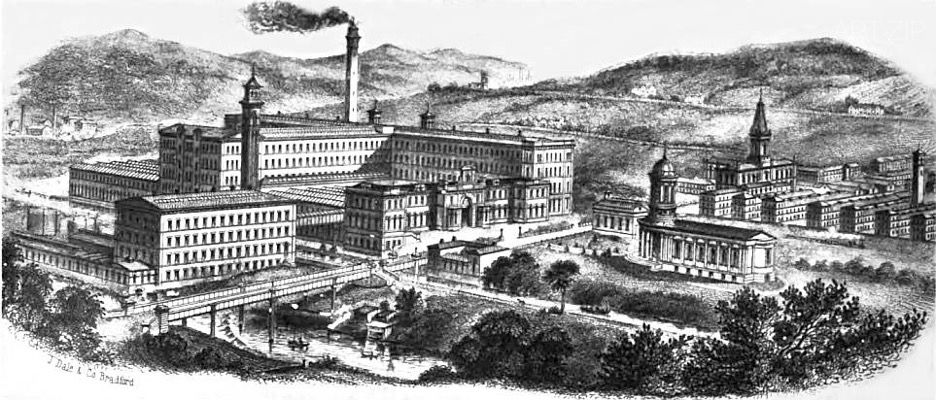
Salts Mill in the Victorian era Image source: Lockwood & Mawson 維多利亞時代的索爾茨紡織廠 圖片來源:Lockwood & Mawson
American artist Ann Hamilton’s installation We Will Sing, situated in the interconnected top-floor galleries of Salts Mill, marks her first large-scale new work in the UK in three decades. Through a non-narrative interplay of sound and material, Hamilton moves beyond abstracted historical reconstruction or commemoration, instead summoning bodily memories tied to labour, migration, and growth. In doing so, she “re-weaves” historical experience into the fabric of the space, allowing the industrial past to resonate not only as a preserved monument but as a living, sensorial presence.
美國藝術家Ann Hamilton的裝置作品「We Will Sing」設於索爾茨紡織廠頂層三間連通的展廳,是她三十年來首次在英國呈現的大型新作。藝術家通過非敘事性的聲音與材料組合,超越了對歷史的抽象化復原與紀念,喚起與勞作、遷徙、成長有關的身體記憶,在歷史空間中「重新編織」歷史經驗。
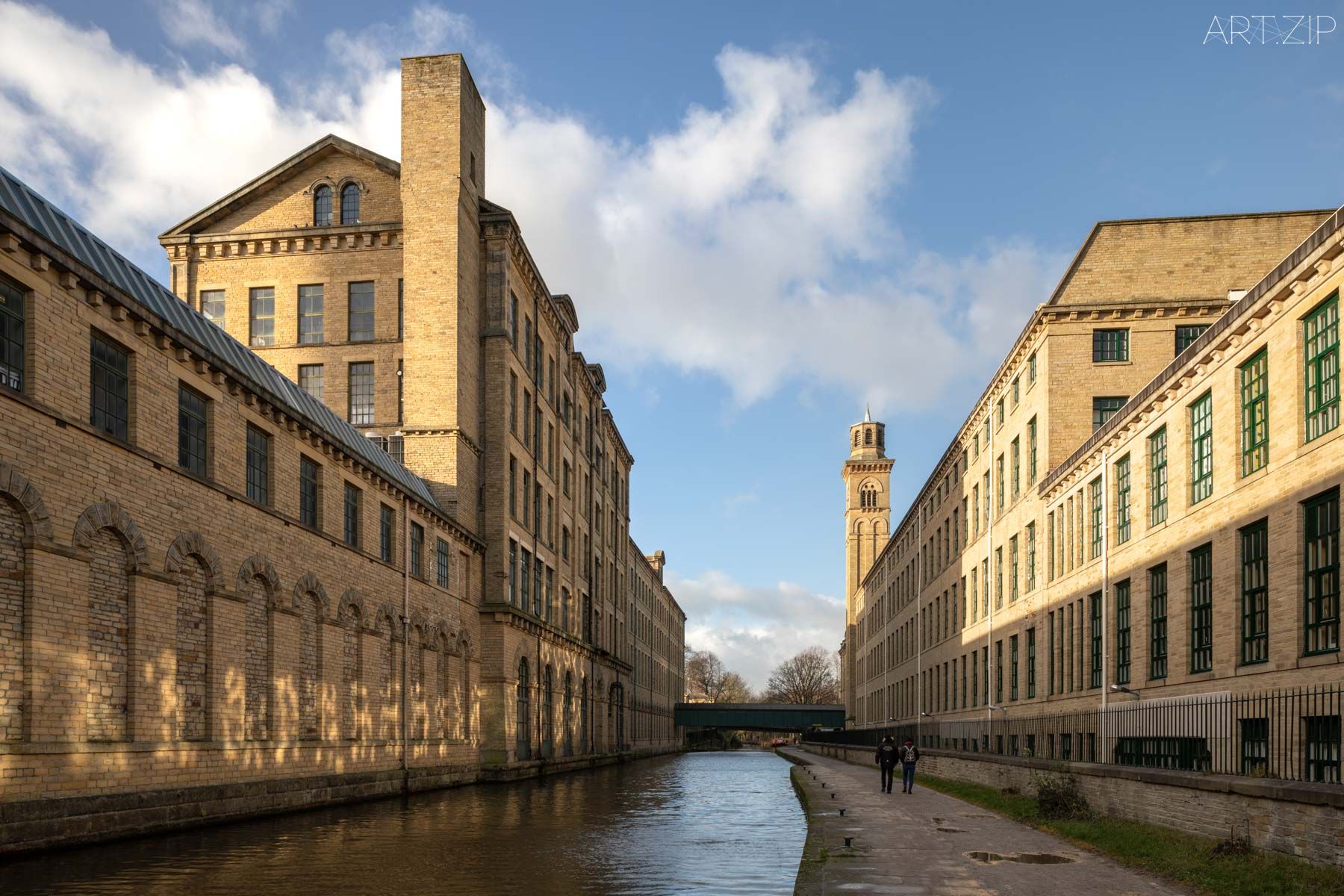
Salts Mill, now transformed into an art space. Credit: Visit Bradford 如今已轉化為藝術空間的索爾茨紡織廠。 Credit : Visit Bradford
Hamilton works in alignment with the building’s own structure, light, and materials, making no superfluous alterations and introducing neither theatrical lighting, platforms, nor textual interpretation. Instead, she uses raw wool and fabrics supplied by two of Bradford’s historic textile firms—H. Dawson and William Halstead—integrating them directly into the existing space. Cotton threads, fibre curtains, and suspended elements are arranged with low density and asymmetry, forming an open spatial relationship. There is no fixed route or designated focal point; the visitor’s movement, pauses, and turns naturally become part of the work itself.
Hamilton順應建築本身的結構、光線與材料,未做多餘改造,也未引入燈光、站台或文字說明,僅在原有空間中使用本地兩家歷史紡織企業H.Dawson和William Halstead提供的原毛與織物。展廳中,棉線、纖維帷幕與懸掛結構以低密度、非對稱的方式分布,構成一種開放的空間關係。展廳無固定動線,亦無明確焦點,觀眾的移動、停留與轉身,自然地成為作品的一部分。
A faint but continuous soundscape fills the galleries—recordings of local schoolchildren and community groups in Bradford. Comprising whispers, repeated syllables, humming, choral fragments, and soft breaths, these sounds are dispersed through surround speakers positioned throughout the space. Hamilton avoids any dramatic amplification; the audio remains close to the floor and walls, allowing it to reverberate and decay among the timber beams, stone walls, and metal piping. Some sounds are recognisable, others register only as vibrations felt in the body—making the auditory experience a central structural element of the work.
Compared to visual elements, sound heightens the interplay between spatial structure and human presence. Its volume is kept at the threshold of ambient noise, merging with the surroundings to create a shared medium of transmission and reflection. The galleries have not been transformed into a neutral white cube; original walls, floors, and beams remain, providing both the physical foundation for sonic resonance and the memory of the factory’s life as a site of industrial production.
The adaptive reuse of Salts Mill’s top floor as a gallery also stands as an exemplary act of re-spatialisation. Through the collaboration of art projects and local communities, the factory retains its historical fabric while taking on new social functions, becoming a cultural space still in active use. Within this setting, Hamilton’s work achieves more than a retrospective gesture: it intervenes in the making of spatial memory and shared public experience.
展廳里微弱但持續的聲音來自布拉德福德當地學校與社區兒童的錄音,這些以呢喃、重復音節、哼唱、合唱與輕微的呼吸所構成的聲音背景,由環繞揚聲器分布在空間各處。Hamilton沒有將聲音推向戲劇化表達,而是讓其貼近地板與牆體,使聲音在木梁、石牆與金屬管道之間回蕩與衰減。部分聲音可被辨識,部分只能以震動的形式被身體感知,聽覺經驗繼而成為作品的關鍵結構。
與視覺相比,聲音更強調空間結構與人的交互。聲音的強度被控制在環境音的邊緣,與周圍環境共同形成傳播與反射的介質。此外,由於展覽空間沒有被清理為中性「白盒」(white cube)*9 ,原始的牆面、地板與橫梁被保留下來,使未加粉飾的歷史空間得以提供聲音介入的物理基礎,也保留了廠房作為工業生產現場的記憶。
承擔展廳功能的索爾茨紡織廠的空間轉化也是「再空間化」實踐的一個範本。通過藝術項目與社區協作,工廠在保持工業遺址原貌的同時,引入新的社會功能,使其成為一個仍在運轉的文化空間。Hamilton的作品在其中所完成的,不僅是對過去的回顧,更是對空間記憶與公共經驗的生成介入。
3.Seeing into Thought: Public Art in a City 由觀入思:一座城市的公共藝術
The interventions described above reveal the latent potential of public art within a so-called non-elite city. Curators have chosen to respect the everyday nature of the exhibition sites, allowing works to coexist with the local topography—woven into walking routes, ramps, pools of water, and disused factories, such that the city itself becomes an active context, a material, and even a participant. Visitors are encouraged to encounter works unexpectedly, dispersed along habitual paths, so that the artistic experience blends seamlessly into daily life, avoiding the one-off spectacle typical of festival-driven events.
The value of public art lies not in creating fleeting moments of wonder for a small circle of cultural tourists, but in its capacity to carry out sustained interventions in the fissures of the city, helping to mend fractured social structures. Sites such as Penistone Hill, Salts Mill, or works like CHANNEL and The Railway Children, positioned along waterways, offer tentative answers to the question of everyday repair: they lend emotional depth to commuting or dog-walking routes and help to restore the bonds between residents and a city whose industrial decline had once disrupted these connections.
上述作品的藝術介入激活了「非精英城市」中公共藝術的實踐潛能。策展人尊重展覽環境的日常屬性,讓作品與地貌共存於步行路線、坡道、水池與廢棄廠房之中,使城市成為活躍的語境、材料,甚至參與者;觀眾亦被鼓勵在常規路徑中偶遇分布式佈置的作品,使藝術體驗融入日常生活,成為其中的一部分,規避了節慶式的一次性消耗體驗。
公共藝術的價值不在於為少數文化遊客製造奇光時刻,而在於它能「在城市裂痕中開展持續介入」*10 ,恢復被割裂的社會結構。Penistone Hill、Salts Mill,抑或沿水體布設的《CHANNEL》和《The Railway Children》,都提供了對「日常修復」的試答:它們使日常通勤或遛狗路徑具備了情感的厚度,讓居民與城市因產業衰退而失聯的紐帶得到重建。
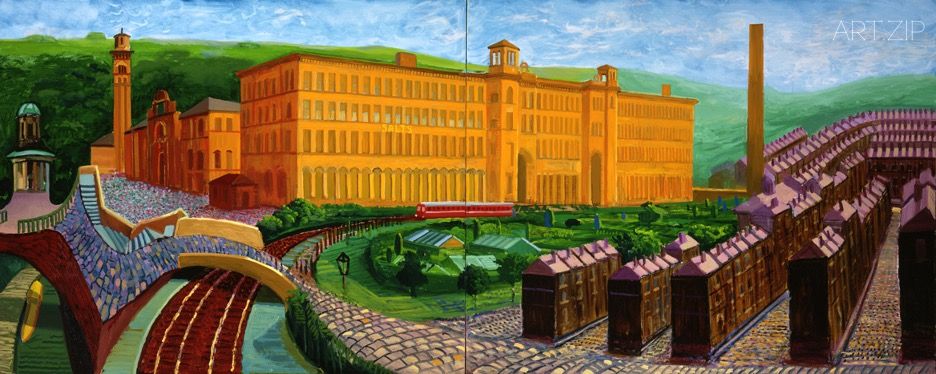
Salts Mill depicted by David HockneyImage source: David Hockney, 1997 David Hockney畫筆下的索爾茨紡織廠 圖片來源:David Hockney, 1997
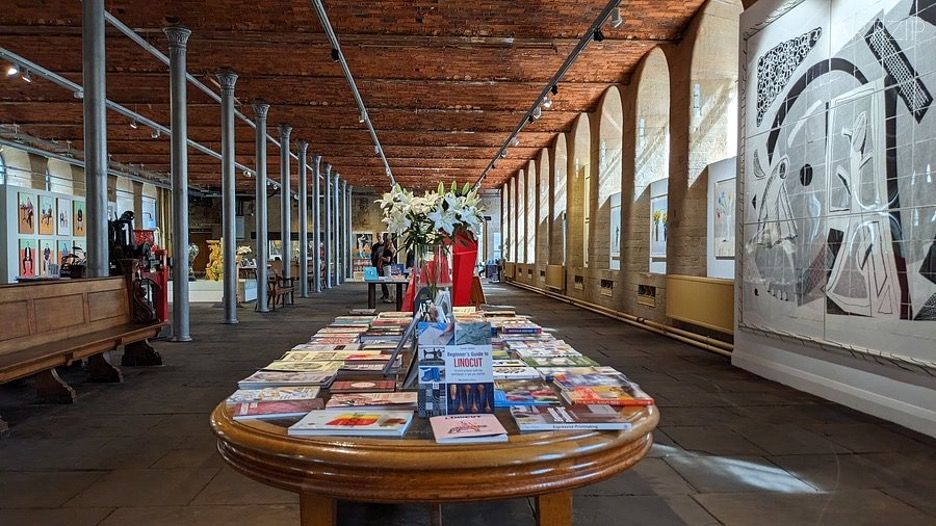
Salts Mill has been transformed into an art space, encompassing galleries, dining, shops, and various others. Image source: 1853 Gallery 索爾茨紡織廠先已轉化為藝術空間,包含展廳、餐飲、商店等多重業態 圖片來源:1853 Gallery
As this year’s cultural protagonist, Bradford has no intention of remaking itself as a grand cultural capital, nor does it claim a ready-made artistic myth. From wool capital to film capital to immigration capital, its cultural identity is still in the making. The very structure of its annual public art programme reflects this openness—curatorial authority is placed in the hands of artists from diverse backgrounds, in an effort to find a shared register of expression within a multiplicity of voices.
This ceding of authorship is especially crucial in Bradford’s social context. On the one hand, it is among the youngest cities in England by demographics; on the other, it holds the lived experience of multi‑generational South Asian communities. When 99 Butterflies brings Peshawar stone‑carving to the Yorkshire moor, the work speaks not only of migration but also of belonging. As Homi Bhabha (1994) reminds us, culture takes shape through encounters between different discursive systems and their mutual rewriting. Bradford chooses to let those differences co‑exist openly, layering the voices of industry, migration, youth, and nature into a shared resonance.
In the end, there is no single answer to the question: who can speak for a city, and who can interpret the direction of its echoes? Such sound is never a single storyline and cannot be rendered by any one individual. It is fragmentary and mobile, carrying traces of memory, judgment, and everyday life; it appears in notes on community walls, rings in the hollow echo of derelict mills, and lingers in thoughts not yet spoken but already present.
Perhaps the meaning of City of Culture lies in a reordering of spatial priorities—who gets heard, and whose experience can be written into the city’s future narrative. The value of public art may rest less in offering definitive answers than in making room for those long treated as background noise, so they can find their own forms of address between retrospection and imagination. Taken together, these scattered yet real voices compose a polyphonic, collectively held cultural legacy.
作為本年度的文化主角,布拉德福德無意自我塑造為文化大城,也沒有既定的藝術神話。從羊毛之都、電影之都到移民之都,它的文化身份仍在形成之中。此次布拉德福德年度公共藝術項目的結構也格外呼應了這點——把策劃權讓渡給來自多元背景的藝術家,試圖在多聲部之間尋找一種可以共同發聲的聲調。
這種讓渡在布拉德福德所處的社會語境中顯得尤為關鍵。一方面,它是英格蘭青年人口比例最高的城市之一;另一方面,它長期承載著多代南亞移民的生活經驗。當《99 Butterflies》以白沙瓦的石刻工藝出現在約克郡荒原上時,作品不僅述說遷徙,也質問歸屬。如Homi Bhabha(1994)*11 所強調的,文化的形成來自不同話語系統的相遇與相互重寫 ,布拉德福德選擇讓這些差異性真實地共處,將工業、移民、青年、自然等多種聲部疊加於一種共振中。
而最終的問題仍然沒有標準答案:誰能表達一座城市的聲音?誰又能來解釋它所回響的方向?這樣的聲音從未是單線的敘事,也無法由某個個體完整呈現。它是碎片的、流動的,攜帶著回憶、判斷與生活的痕跡;它出現在社區牆面的留言里,也浮現在廢棄廠房的空響中,還潛藏於那些尚未說出、卻已存在於人們心中的聲音之間。
「文化之城」的意義,也許在於一次空間秩序的重新排列——誰能被聽見,誰能夠把自身經驗嵌入這座城市的未來敘述之中。公共藝術的價值,或許並不在於回答確切的問題,而在於為那些長期被忽視的人群留出應聲的空間,使他們在回望與想象之間,找到自己的表達。這些分散卻真實的聲音,最終將共同構成一份聲部多元、共同參與的文化遺產。
Postscript 後記
In the early summer of 2025, I was invited to visit Bradford. Before setting out, I learned from conversations with my London neighbours that, in the eyes of many people in Britain today, it is an industrial city belonging to South Asian immigrants. The word immigrant, in the current climate of social conflict, would seem to remain an inevitably sensitive topic; and the words industrial city cannot help but evoke a fate of loss, obsolescence, and marginalisation.
What I encountered upon arrival went beyond the expectations that had been laid out for me in advance. The streets were clean, the small square in front of the train station calm and orderly, and the city was covered with posters and slogans for the City of Culture. Such a sense of collective pride seems increasingly rare in large metropolises, where rifts between boroughs, between ethnic groups, and between classes seem endlessly contentious; here, there was an unexpected clarity, even purity.
This was not the result of an overnight transformation. Bradford had also experienced the upheavals suffered by many other British cities. In 2001, a large-scale riot broke out here. Shops were destroyed, and both police and demonstrators were injured—becoming one of the most serious outbreaks of violence in Britain in decades. Yet only ten years later, during the London riots of 2011 that spread across the country, Bradford was strikingly calm. The curator who accompanied our visit proudly mentioned that, in that year, almost every sneaker shop in the country had been looted—except here, where not a single one was touched, because local young people had collectively decided “not to do such a thing.”
What, then, enabled the city to change so markedly within a decade? From policy support to community governance, it is not hard to imagine that complex structural factors were at work. Yet from another angle, perhaps the more intriguing question is this: under the capital’s constant siphoning of resources and talent, what allows a city to hold on to its young people? And what can it offer them, to nurture enough recognition and identification that they would willingly safeguard its order and dignity?
I have no answer.
Two days and one night were far from enough to let me fully understand Bradford, yet my impressions were real. While trekking across the upland moors outside the city, we encountered many local residents walking their dogs. They were warm and friendly, carrying with them a deep affection for this land. They told me: “What’s the Cotswolds? We have the most beautiful countryside in all of England right here in Bradford.” Such love and pride for the land may well be a subtle force underlying the changes of recent years, and this, perhaps, is where public art, in the truest sense of the word public, can take part and make its contribution.
筆者於2025年初夏受邀參訪布拉德福德。出發前從與倫敦鄰居的交談中得知,在當下多數英國居民的印象中,那是屬於南亞移民的工業城市,而「移民」一詞,在當下英國的社會衝突中,似乎總歸是一個敏感的話題,「工業城市」這幾個字也不免令人聯想到失落、陳舊與被邊緣化的命運。
真正抵達後的視線所及,超出了我短時間內被他人鋪墊的預期。道路乾淨,火車站前的小廣場安靜有序,全城張貼「文化之城」的海報與標語。這種集體的榮譽感在大都市中似乎愈發稀有——區與區之間、種族之間、階級之間似乎總有爭吵不休的裂隙,而這裡,意外的純淨。
這背後不是一蹴而就的過程,布拉德福德也曾經歷過英國眾多城市所遭受的震蕩。2001年,一場大規模騷亂在此爆發,商鋪被毀,警察與示威者皆有多人受傷,幾乎成為英國本土數十年來最嚴重的暴力事件之一。可短短十年後,在2011年蔓延全國的倫敦暴亂中,布拉德福德卻出奇地平靜。陪同我參訪的策展團隊女士驕傲地提到,那年全國各地的球鞋店幾乎無一幸免,唯有這裡的毫髮無損,因為當地年輕人一致決定「不去做這種事」。
是什麼,讓這座城市在十年間發生了如此變化?從政策支持到社區治理,不難想象這背後一定有複雜的結構性因素。但從另一個角度來想,這或許是個更有趣的問題:在首都的虹吸效應之下,一座城市憑什麼能夠留住年輕人?這座城市又能給予他們怎樣的滋養,使他們生出足夠的認同,從而自覺守護它的秩序和尊嚴?
我沒有答案。
兩天一夜的旅程不足以讓我全面理解布拉德福德,但我的感受是真實的。在市外的高原荒地上跋涉時,我們碰到不少本地遛狗的居民,他們熱情、友好,帶著對這片土地真摯的愛意。他們說:「科茨沃爾德 (Cotswolds) 算什麼?我們布拉德福德才有全英國最美的鄉村。」這種對土地的愛與自豪,也許正是種種變化背後的一種微妙力量,而這,或許也是公共藝術——真正意義上的「公共」藝術——能參與其中並為之貢獻的。
Footnote 註腳:
*1 The Brontë sisters were famous 19th-century British novelists who lived for many years in Haworth, near Bradford. The Yorkshire moorland landscapes profoundly influenced their literary works.勃朗特三姐妹是英國19世紀著名作家,她們長年生活在布拉德福德附近的哈沃斯,約克郡的荒原風光深刻影響了她們的文學作品。
*2 Written in 1906 by the British author Edith Nesbit (E. Nesbit), this work is regarded as a classic in the history of British children’s literature. Its influence has been far-reaching, with multiple adaptations for film and television—the most notable being the British films of 1970 and 2000, as well as several BBC series.由英國作家伊迪絲·內斯比特(E. Nesbit)於1906年創作,被視為英國兒童文學史上的經典之作。其影響深遠,曾多次被改編為電影和電視劇,最具代表性的是1970年與2000年的兩版英國電影,以及BBC的多部劇集。
*3 Shanaz Gulzar said:“Wild Uplands is where art, nature and Bradford’s heritage converge — a deep dialogue between the landscape, the seasons, and the people who experience it. 《Wild Uplands》是藝術、自然與布拉德福德歷史的交匯點,是風景、季節與人之間的對話。”
*4 In 1917, two girls near Bradford claimed to have photographed fairies, sparking a nationwide sensation. Even the writer Arthur Conan Doyle voiced his support. Many years later, they admitted the photos were faked, yet the incident is still regarded as a classic case in both British folklore and the history of photography.1917年,布拉德福德附近的兩個女孩聲稱拍攝到了仙女照片,引發全國轟動。連作家柯南·道爾也表示支持。多年後她們承認照片是偽造的,但此事件至今仍被視為英國民間信仰與影像歷史的經典案例。
*5 A 13th-century cosmography by the Persian scholar Zakariya al-Qazwini, blending science, myth, and religious imagination. It was widely circulated across the Islamic world and had a lasting influence on later traditions of natural history imagery. 13世紀波斯學者札卡里亞·卡茲維尼所著的宇宙志作品,融合科學、神話與宗教想象,廣泛流傳於伊斯蘭世界,對後世自然史圖像學影響深遠。
*6 Mahmoud Darwish (1941–2008), known as the “Palestinian national poet,” was one of the foremost figures in modern Arabic literature. 馬哈茂德·達爾維什(1941-2008),「巴勒斯坦民族詩人」,阿拉伯文學代表作家之一。
*7 The village of Saltaire was planned and built in the mid-19th century by the textile magnate Titus Salt. It was equipped with workers’ housing, a school, hospital, library, church, and park, forming a self-sufficient model industrial community. It embodied Victorian industrialists’ pursuit of a “moral working environment” while also reflecting the complex tensions between industrial capital and social welfare. A staunch teetotaler, Salt banned pubs within the village—an unusual design choice that expressed his Puritan values. He believed that good living and educational conditions, combined with a temperate lifestyle, would shape an orderly, clean, and elevated working class, thereby contributing to the moral improvement of society. 薩爾泰村由毛紡商Titus Salt於19世紀中葉規劃建設,配備了工人住房、學校、醫院、圖書館、教堂與公園,形成一個自給自足的理想型工業社區。它不僅體現了維多利亞時代工業家對「道德勞工環境」的探索,也反映出工業資本與社會福利之間的複雜張力。作為堅定的禁酒主義者(Teetotaler),Salt在村內禁止設立酒館(pub),這一獨特設計展現了他的清教徒價值觀。他相信,通過良好的居住與教育條件,再結合節制的生活方式,能夠塑造一個秩序井然、清潔高尚的工人階層,進而實現對社會道德的改良。
*8 At the time of its construction, it was one of the largest industrial buildings in the world. The mill had three storeys, with the main block stretching about 168 metres, capable of housing more than 3,000 workers. After production ceased in the late 20th century, Salts Mill was purchased in 1987 by entrepreneur Jonathan Silver, who gradually transformed it into a cultural and commercial complex. Today, it houses galleries, a bookshop, cafés, design stores, and creative offices. The highlight is its extensive permanent display of works by David Hockney. Born in Bradford and deeply connected to the region, Hockney also personally contributed to the planning of some of the gallery spaces. 建成之時,這是當時世界上最大的工業建築之一,整座廠房共三層樓,主樓長約168米,能容納超過3000名工人。20世紀後期工廠停產後,Salts Mill於1987年由企業家Jonathan Silver購入,並逐步轉型為文化藝術與商業綜合空間。如今的廠房內部設有畫廊、書店、咖啡館、設計商店和創意辦公空間,其中最引人注目的部分,是對大衛·霍克尼(David Hockney)作品的大規模常設展出。霍克尼出生於布拉德福德,與該地區有深厚淵源,他也親自參與了部分展廳的策劃。
*9 A typical form of contemporary art exhibition space, characterised by white walls, even lighting, and a neutral environment, intended to eliminate distractions and focus solely on the artwork. The term originates from 20th-century modernist exhibition practices, later criticised for producing a “dehistoricised” viewing experience and symbolising elite culture. 當代藝術展覽空間的典型形式,特點為白牆、均勻照明與中性環境,旨在消除干擾、聚焦藝術本身。該術語源自20世紀現代主義展覽實踐,後被批評為製造“去歷史化”的觀看機制與精英文化象徵。
*10 See British art scholar Claire Bishop’s views on the value of public art in her book Artificial Hells (2012). 參考英國藝術學者Claire Bishop(2012)在《Artificial Hells》一書中關於公共藝術價值的觀點。
*11 See cultural theorist Homi K. Bhabha’s perspective in his seminal work The Location of Culture. 參考文化理論家Homi K. Bhabha的觀點,出自他的代表作《The Location of Culture》。
*12 Sneaker stores are often among the first shops looted during riots.球鞋店是騷亂中最易遭搶的商鋪。
*13 The Cotswolds is a famous rural region of England, celebrated for its rolling hills, stone cottages, and idyllic landscapes, widely acclaimed as “the most beautiful countryside in England”. Cotswolds是英國著名的鄉村地區,以連綿的山丘、石屋與田園風光聞名,被廣泛譽為「英格蘭最美的鄉村」。
Note: This article was originally written in Chinese and later translated into English by the author using AI technology.
Text by 撰文 x 張幻芷 Zhang Huanzhi































